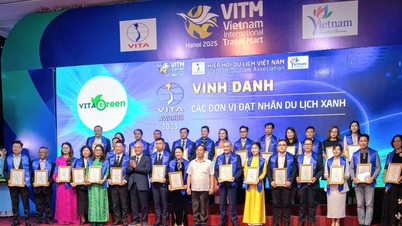 |
| Global value chains, supported by digital technology, benefit developing economies because they make it easier for them to diversify from goods to higher value-added manufactured goods and services. (Source: heidoc.net) |
Today's rapidly changing globalized world presents businesses with both opportunities and challenges in three key new trends impacting product value chains: the growth of global value chains, changes in corporate strategy, and a focus on brand development.
The rise of global value chains
The fragmentation of production processes at the global level creates new opportunities for integration between rich and poor economies. Global value chains, supported by digital technology, benefit developing economies by making it easier for them to diversify from goods to higher value-added manufactured goods and services. This involves breaking down production processes to perform steps in different countries instead of a single country mastering the entire production of a product for export.
With value chains, a country can specialize in one or more activities in which it has a competitive advantage. This separation of production began in advanced economies to cope with competition and reduce logistics costs, then spread globally as major developing economies opened up. However, global value chains also require participating businesses to have large economies of scale. This is a major challenge for businesses in countries with less favorable capital mobilization environments.
Changes in business strategy
Businesses tend to focus on high value-added segments in the product value chain, such as research and development, product design, marketing, and after-sales service. Segments like manufacturing and assembly have lower added value.
Therefore, given the context of product value chains extending and expanding globally during the integration process, multinational corporations tend to outsource low-value-added segments to developing countries. This also presents an opportunity for developing countries to attract investment and develop partnerships to improve their production and business capabilities in the short and medium term.
Nevertheless, in the long-term strategy, developing countries and businesses need to develop and expand their participation in high value-added segments to improve efficiency. In the short term, breakthroughs in marketing (pricing, sales, etc.) are needed through the development of product and service brands, as branding is increasingly important for high-tech products and in countries with developed financial markets.
Focus on brand development.
Global value chains and value-added segments offer opportunities for businesses in countries that were previously only manufacturing and assembly plants to move up the value chains, such as building their own brands to enhance their reputation in investment partnerships and increase their value in domestic and international financial markets. Globally, economists agree that branding serves a crucial economic function in creating added value for products and guiding aggregate demand.
In Vietnam, the history of building and developing Vietnamese product brands has seen many ups and downs. Vietnam's consumer goods industry boasts brands that were once a source of pride, such as Co Ba soap, La Dalat cars, Da Lan toothpaste, Truc Bach beer, and Thorakao cosmetics. However, some brands have survived to this day, some have "disappeared," and others seem to be "dormant."
Currently, Vietnam has over 800,000 enterprises (approximately 98% are small and medium-sized enterprises (SMEs)), including over 22,000 FDI enterprises and nearly 900 state-owned enterprises (SOEs). Vietnamese enterprises have gradually built strong brands in manufacturing sectors such as electronics, automobiles, agricultural products, footwear, and textiles, aiming to create added value for products not only domestically but also globally.
However, state-owned enterprises (SOEs) seem to have "fallen asleep" in developing product brands within the global value chain due to issues of ownership, monopolies, and short-term thinking, leading to wasted resources and affecting the quality of service to the people as well as national competitiveness.
The development and continuous innovation of the institutional structure of enterprises to create more added value for products and effectively serve the people is an important content in perfecting the market economy institution, contributing to effective economic integration. Therefore, the Resolution of the 13th National Congress of the Party requires: "Focus on perfecting a synchronous and modern market economy institution based on full compliance with the laws of the market economy and deep international economic integration."
Proposed solutions for Vietnam
In order to contribute to the implementation of the Party's guidelines and the effective development of social capital through institutional and structural reforms of enterprises in the context of changing international trade trends, I would like to offer three proposals:
Firstly, the joint-stock company model: Given that most Vietnamese businesses face challenges related to economies of scale due to limited access to capital, the joint-stock company model is a modern solution for business organization, combining the advantages of common ownership and professional management.
This innovative model has transformed the business landscape, increasing access to capital, scaling up operations, and promoting transparency. As one of the most important institutions in global business, the joint-stock company has become the most popular business model for large-scale enterprises.
In practice, although the number of joint-stock companies in Vietnam is still limited and their management is complex, they are a type of company that needs to be focused on developing because they possess many advantages in a market economy, such as flexibility and quick adaptation to innovation.
On the other hand, it is necessary to strengthen the equitization of state-owned enterprises and commercial banks to leverage financial capital resources in improving labor productivity and transparency.
Secondly, brand building and protection: Businesses need to study global value chains and manufacturing hubs around the world, in addition to Vietnam, and gradually develop strategies for producing goods under their own brand to effectively exploit the product value chain, enhance reputation, and improve competitiveness in the context of globalization. However, businesses using outsourcing strategies should not stray too far from their core values such as the local market and technological know-how to avoid risks when the supply chain changes. Furthermore, measures to protect the brand in the business market are also necessary.
Thirdly, the business environment: The State needs to create a favorable business environment for enterprises in general and joint-stock companies in particular. It is necessary to research and gradually build a legal framework to facilitate the development of joint-stock companies; in the short term, relevant laws regarding taxation and the financial market should be improved…
In particular, the financial market needs to develop in a synchronized and modern direction for all types and structures of businesses, in order to maximize the efficiency of social resources to promote financial resources, enhance cooperation and competitiveness of the business community in the global value chain, and ensure the effectiveness of the country's international economic development and cooperation. In this process, developing a digital technology ecosystem plays a crucial role in building a favorable environment for modern business structures to operate effectively alongside the process of globalization.
Coupled with the government's effective management of the financial market and the continuous innovation and restructuring of corporate institutions by the business community, the "Made in Vietnam" brand will increasingly develop in the digital economy era, contributing to enhancing the competitiveness of the national economy.
Source


![[Photo] Closing Ceremony of the 10th Session of the 15th National Assembly](/_next/image?url=https%3A%2F%2Fvphoto.vietnam.vn%2Fthumb%2F1200x675%2Fvietnam%2Fresource%2FIMAGE%2F2025%2F12%2F11%2F1765448959967_image-1437-jpg.webp&w=3840&q=75)

![[Photo] Prime Minister Pham Minh Chinh holds a phone call with the CEO of Russia's Rosatom Corporation.](/_next/image?url=https%3A%2F%2Fvphoto.vietnam.vn%2Fthumb%2F1200x675%2Fvietnam%2Fresource%2FIMAGE%2F2025%2F12%2F11%2F1765464552365_dsc-5295-jpg.webp&w=3840&q=75)






















































![[OFFICIAL] MISA GROUP ANNOUNCES ITS PIONEERING BRAND POSITIONING IN BUILDING AGENTIC AI FOR BUSINESSES, HOUSEHOLDS, AND THE GOVERNMENT](https://vphoto.vietnam.vn/thumb/402x226/vietnam/resource/IMAGE/2025/12/11/1765444754256_agentic-ai_postfb-scaled.png)




















































Comment (0)